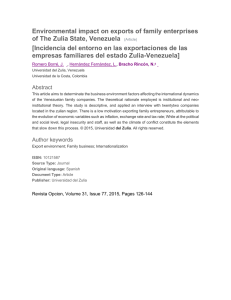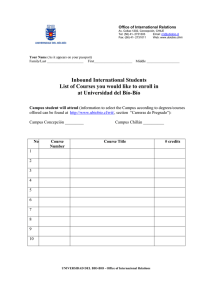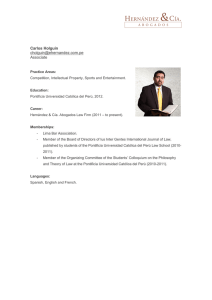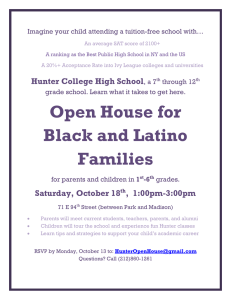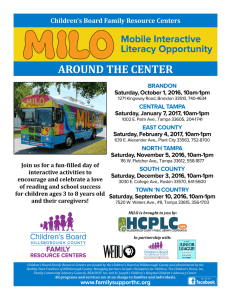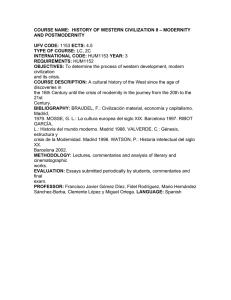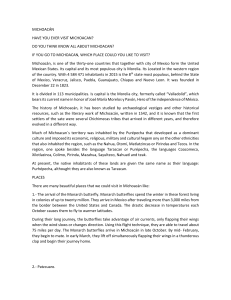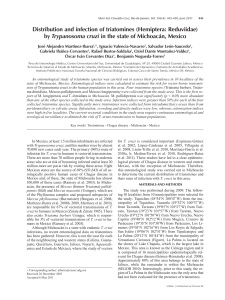Ourselves and Others: Devices of Identity
Anuncio
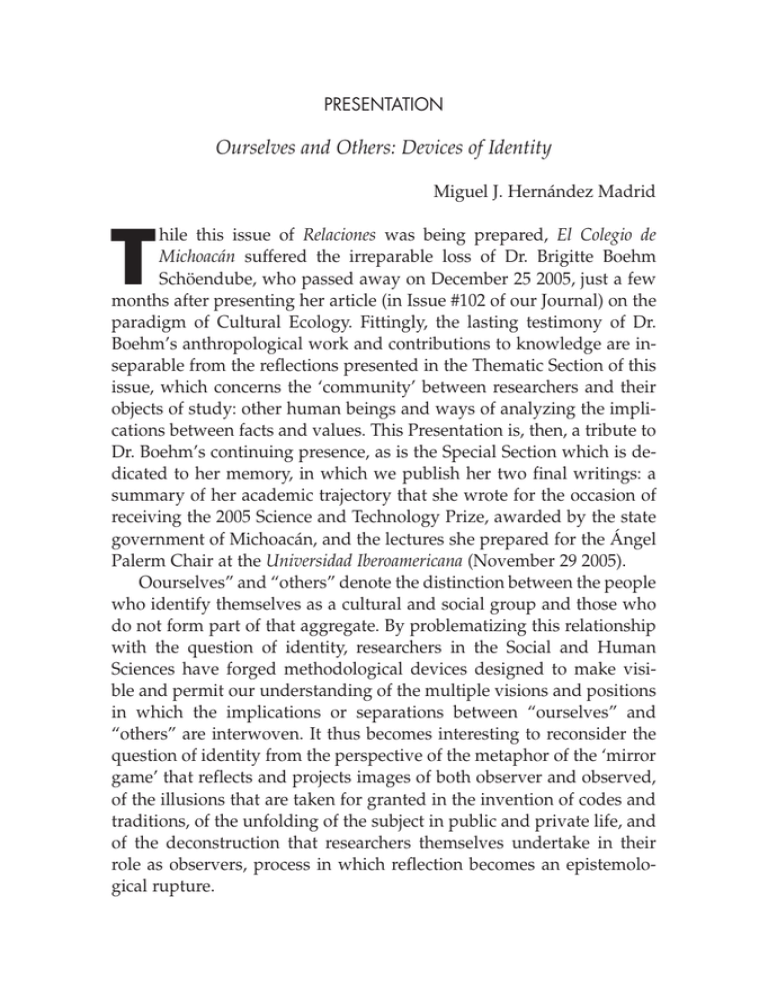
PRESENTATION Ourselves and Others: Devices of Identity Miguel J. Hernández Madrid T hile this issue of Relaciones was being prepared, El Colegio de Michoacán suffered the irreparable loss of Dr. Brigitte Boehm Schöendube, who passed away on December 25 2005, just a few months after presenting her article (in Issue #102 of our Journal) on the paradigm of Cultural Ecology. Fittingly, the lasting testimony of Dr. Boehm’s anthropological work and contributions to knowledge are inseparable from the reflections presented in the Thematic Section of this issue, which concerns the ‘community’ between researchers and their objects of study: other human beings and ways of analyzing the implications between facts and values. This Presentation is, then, a tribute to Dr. Boehm’s continuing presence, as is the Special Section which is dedicated to her memory, in which we publish her two final writings: a summary of her academic trajectory that she wrote for the occasion of receiving the 2005 Science and Technology Prize, awarded by the state government of Michoacán, and the lectures she prepared for the Ángel Palerm Chair at the Universidad Iberoamericana (November 29 2005). Oourselves” and “others” denote the distinction between the people who identify themselves as a cultural and social group and those who do not form part of that aggregate. By problematizing this relationship with the question of identity, researchers in the Social and Human Sciences have forged methodological devices designed to make visible and permit our understanding of the multiple visions and positions in which the implications or separations between “ourselves” and “others” are interwoven. It thus becomes interesting to reconsider the question of identity from the perspective of the metaphor of the ‘mirror game’ that reflects and projects images of both observer and observed, of the illusions that are taken for granted in the invention of codes and traditions, of the unfolding of the subject in public and private life, and of the deconstruction that researchers themselves undertake in their role as observers, process in which reflection becomes an epistemological rupture. The topics of the five articles brought together in the Thematic Section share a concern: to examine how the “other” has been constructed and to propose methodological approaches that will reveal this process. We begin with José Ramón Narváez Hernández, whose study analyzes the juridical situation of the Indian in Mexico at different moments in which the country’s Civil Codes have –over the course of almost two centuries– feigned their non-existence and taken their legal representation upon themselves. Narváez supports his critique of these legal dispositions that deny indigenous peoples juridical personality as ‘citizens’ on Mexico’s adoption of the Napoleonic Code in the early 19th century. He then examines the contradictions and forms of juridical violence that led to the conformation of the Indians as an “abstract subject”, alienated from the practices of private jurisprudence that elucidate their ‘uses and customs’. David Robichaux adopts an ethnographic approach to analyze the problem of the meanings of the terms “Indian” and “Mextizo” in southwestern Tlaxcala, and to question the application of essentialist focuses that take for granted a series of subjective features of ethnic groups anchored in a certain way of being. The author suggests that we rescue the model of the “Indian-Mestizo continuum” in order to define objective indicators of identity and ethnicity, and emphasizes the importance of cargos in communitarian organization. His article is a demonstration of the methodological application of this model that compares transformations in the use and learning of the Náhuatl language in several Tlaxcalan towns. In his article, Hugo José Suárez first introduces us to the images of Julio Cordero, a Bolivian photographer, and then goes on to analyze their symbolic representations of the society of La Paz in the early 20th century. Suárez’ study invites the reader to a sociological reflection on views of modernity, social classes, and the ideology of progress, similarly captured in other latitudes by the lenses of such noted photographers as Martín Chambi in Peru, and by community photographers like Martiniano Mendoz in Zacapu, Michoacán,1 who present material that See, Lunwerg Editores, Martín Chambi, 1920-1950, Madrid, Círculo de Bellas Artes y Lunwerg, 1990. See also, Luis Ramírez Sevilla, Villa Jiménez en la lente de Martiniano Mendoza, Zamora, Michoacán, El Colegio de Michoacán/Instituto Michoacano de Cultura, 2002. 1 is not only illustrative but also stimulates one to reflect upon the modern image from a methodological standpoint. Cristina Monzón rescues the names of the Tarascan gods in order to analyze and interpret their meanings etymologically and then propose an approximation to the cosmovision and culture of the people that created them. Monzón’s research is based on her intimate understanding of the works of Jerónimo de Alcalá, dictionaries and other “arts” from the second half of the 16th century that were elaborated by friars, sources that she has examined also in earlier publications. The Thematic Section ends with a paremiological analysis by Herón Pérez of Mexican refrains involving horses and women, which he uses to elucidate a kind of social semiotics that reveals certain realities that underlie daily life and are perceived in their false appearances. In this article, the author explores “ranchero” language and its many refrains that establish an analogical relation between the horse and women to explain prescriptions placed on the condition of women, derived from an ancestral Christian and Greek tradition. In the Documents Section, we publish the synthesis of a Roundtable debate on the topic of open access to knowledge that was held on the occasion of the 26th Anniversary of El Colegio de Michoacán and the publication of Issue #100 of the Journal Relaciones. Organized by Dr. Andrew Roth, at that time Editor of the Journal, the Roundtable presented distinct points of view on the proposals and expectations generated by the “Budapest Initiative on Open Access” (2001), which proposes disseminating and sharing academic publications through the print and electronic media on a wider scale to increase access. In our General Section, Cecilia Adriana Bautista García presents an article on the educational struggle in Mexico between 1930 and 1940. Based on a thorough review of the ‘state of the question’, Bautista focuses on the problem of anticlerical acts by teachers and their connections with ‘freethinker societies’, and sustains the hypothesis that Masonic organizations emerged as new political-social spaces from which several teachers launched a revitalized anticlerical action linked to the socialist reform of education fostered by the State. Traducción de Paul C. Kersey LOS AUTORES JOSÉ RAMÓN NARVÁEZ HERNÁNDEZ. Doctor en investigación en Teoría e Historia del Derecho por la Universidad de Florencia (Italia) con mención honorífica, licenciado en derecho mención cum laude por investigación científica, Universidad Panamericana. Ha hecho estancias de investigación en América y Europa. Ha escrito para importantes revistas especializadas en Italia, Brasil, Chile, España y México. Profesor de las materias de Historia del Derecho, Sociología histórica del derecho, Argumentación Jurídica y Ciencia Jurídica, Derecho Comparado, Estado de Derecho y Derecho indígena. DAVID ROBICHAUX. Nacido en Nueva Orleáns, reside en México desde 1966. Estudió Historia en la Universidad de Nueva Orleáns y obtuvo el título de Bachelor of Artes con dicha especialidad en la Ohio Northern University, en Estados Unidos. Obtuvo la maestría en Antropología Social en la Universidad Iberoamericana, ciudad de México, el Diplôme en Études Approfondies de la Escuela de Altos Estudios de Ciencias Sociales de París en Sociología y el Doctorado en Etnología en la Universidad de París X (Nanterre). Desde 1977 es profesor/investigador en la Universidad Iberoamericana. Sus investigaciones se han centrado en distintos aspectos de la familia, el grupo doméstico y las redes de parentesco entre los grupos indígenas de Mesoamérica, en donde ha combinado el trabajo de campo antropológico con el método de la reconstitución de familias de la demografía histórica. Ha publicado numerosos artículos en revistas y libros editados en Argentina, Cuba, Estados Unidos, Francia, México y Portugal. HUGO JOSÉ SUÁREZ. Doctor en sociología por la Universidad Católica de Lovaina, Bélgica (2001). Publicaciones recientes: “Une mystique de la politique. Sur l’engagement de prêtres ouvriers dans la guérilla révolutionnaire en Bolivie“, in Actes de la Recherche en Sciences Sociales, núm. 155, París, diciembre, 2004 ; ”La religión en la sociedad red: la experiencia de América Latina”, en Manuel Castells y Fernando Calderón (compiladores), ¿Es sostenible la globalización en América Latina?, Santiago, Ed. Fondo de Cultura Económica, 2003; La transformación del sentido. Sociología de las estructuras simbólicas, La Paz, Ed. Muela del Diablo, 2003; ¿Ser cristiano es ser de izquierda? La experiencia político-religiosa del cristianismo de liberación en Bolivia en los años 60, La Paz, Ed. Muela del Diablo, 2003. Fue investigador del Programa de Naciones Unidas para el Desarrollo-Bolivia, equipo con el cual realizó tres informes nacionales de desarrollo humano. Redactor Asociado de la revista Actes de la recherche en sciences sociales del Colegio de Francia. Ha impartido cursos de grado y posgrado en la Universidad de Guanajuato, Universidad Autónoma del Estado de Morelos, Universidad de la Cordillera (Bolivia), Universidad Católica Boliviana y Universidad Mayor de San Andrés (Bolivia). Profesor-investigador en el Centro de Investigaciones en Ciencias Sociales de la Universidad de Guanajuato. CRISTINA MONZÓN. Doctorado en lingüística, UNAM. Su interés principal es el estudio morfológico y sintáctico de la lengua p’urhépecha en documentos tarascos coloniales así como en las variantes habladas en varias comunidades del estado de Michoacán. Actualmente es investigadora de El Colegio de Michoacán y entre sus publicaciones se tiene Los morfemas espaciales del p’urhépecha; significado y morfosintaxis, Zamora, El Colegio de Michoacán, 2004; Edición, transcripción y notas de Arte de la lengua de Michuacan compilada por el muy reverendo padre Fray Matutino Gylberti, vol. II, Zamora, El Colegio de Michoacán, 2004; “Tradition and Innovations in Sixteenth Century Grammars of New Spain”, en Elke Nowak (ed.), Languages Different in All Their Sounds... Descriptive Approaches to Indigenous Languages of the Americas 1500 to 1850, Studium Sprachwissenschaft, Beiheft 31, Münster, Nodus Publikationen, 1999, 31-51. HERÓN PÉREZ MARTÍNEZ. Investigador titular C de tiempo completo del Colegio de Michoacán, doctorado en letras especialidad en lenguas románicas por la Université de Bourgogne. Su ámbito de intereses disciplinas como la lingüística, teoría del discurso, la retórica, la hermenéutica y, en general, todo lo relativo al texto. Actualmente, sus principales líneas de investigación están conformadas por El folclore mexicano en donde estudia, como parte de su interés fundamental por la paremiología mexicana, tanto “las estructuras y rasgos discursivos de la argumentación paremiológica” como las relaciones entre paremiología y fraseología mexicanas. Igualmente, como parte de sus estudios del folclore mexicano, estudia las calaveras en el contexto de la sátira popular mexicana amén de una serie de temas, tópicos y formas del cancionero mexicano. Entre su ámbito de intereses está también la semiótica de la cultura mexicana, la obra del humanista mexicano Alfonso Méndez Plancarte y la poética de Sor Juana Inés de la Cruz. Ha publicado sobre estos temas una veintena de libros y más de un centenar de artículos especializados. CECILIA ADRIANA BAUTISTA GARCÍA estudió la licenciatura en Historia en la Universidad Michoacana de San Nicolás de Hidalgo. Maestra en historia por el Colegio de Michoacán, con la tesis “Clérigos virtuosos e instruidos: dos proyectos de reforma clerical en un obispado mexicano. Zamora, 1867-1882”. Es candidata a doctora en historia por El Colegio de México, con la tesis “Entre la pugna y la conciliación: las disyuntivas del Estado y la Iglesia en la consolidación del Estado liberal. México, 1856-1914”, dirigida por el doctor Marcello Carmagnani F. Actualmente es becaria del programa Estudiantes Distinguidos 2005, del Instituto Nacional de Estudios Históricos sobre la Revolución Mexicana.
